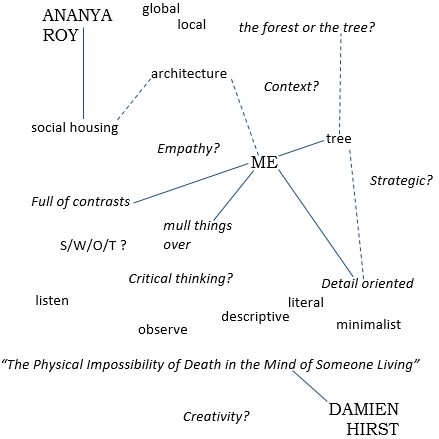Reflect. Inspect. Connect.
Words and phrases, is usually how I begin to think about almost anything and everything. Little bits of thought here and there cluster together formulating a rather incoherent jumble which, when put onto paper, might looking something along the lines of this:

This was a part of the collections of ideas, individuals, and inscriptions which were strewn across my mind when I was faced with this introspective blog piece. Yet, beneath this seemingly incomprehensible mound of words there must be a coherent reasoning that continues to kindle the fire of my back burner. Just as Fulton-Suri (2007) emphasizes in the short excerpt of Thoughtless Acts: Observations on Intuitive Design, behaviour is an output of motivation. Such behaviour is a response which has been curated by the individuals’ surroundings, experiences – in short, their identities – and therefore, we must be wholly conscientious of behaviour and thoroughly investigate where the motivation for such behavior could possibly lie. One critical tool Fulton-Suri (2007) introduces is the power of questioning, to simply ASK.
Admittedly, I’m not too great at questioning things. This was clearly evident during the Business in a Backpack activity where I was quick to accept the initial ideated concept and run with it, no questions asked. I took in every piece of resource shared by the group thinking of each object as if it were a piece in a puzzle – and no puzzle is complete with a missing piece. Likewise, my reactions also brought to light my personality, values and desires: eager to connect the dots and persistent in pursuing the envisioned product, all the while falsely identifying cohesiveness and mutual agreement as evidence of positivity, which may not always be the case. During the activity, I became entirely fixated on designing the prototype of the concept that I had momentarily forgotten about the remaining context of the activity, such as circumscribing a target audience for the product.
Recently, while playing a puzzle game Unblock Me (Kiragames, 2014) I discovered that I was unconscientiously performing moves which were illogical, a waste of my allotted number of moves, and therefore unnecessary. I found that being truly conscientious of one’s own actions involved a good deal of pondering and recalibrating my own perspective in order to think about how to think differently. Questioning my curiosity to critically seek out whether the right questions are being asked. Perhaps, that puzzle piece was meant to be missing. What complete means may differ between individuals – to what degree of completeness does each person register with (Osterwalder, Pigneur, Bernarda & Smith, 2014)? And of course, after all the hum-and-hawing, one still needs to go ahead and just TRY.
As singular individuals, attempting to complete a task alone might seem like a daunting feat. This is because while individuals may need to outsource in order to supplement weaknesses, working as a group creates the possibility to insource to complement while additionally providing an emotional airbag of support. In The Ten Faces of Innovation, the author Kelley (2005) identifies ten different personas which are integral in building a team that enables innovation. Although one individual may not be able to take on all the personas at once, each team member could have multiple personas to switch to and fro so as to balance the needs of the project group. The team SWOT (Strengths, Weaknesses, Opportunities, Threats) activity demonstrated that a weakness voiced by one member could be compensated by the strength of another. It is with this process that the me of an individual can potentially transform into a we that corresponds to an organization.
Knowing that the readings and activities thus far are samplings of what is to come, I await in anticipation of the tools I will be gaining to become a strategic designer. In the process of writing of this blog, I am journaling, I am DO-ing – I am introspecting and questioning: how will I design my ASK.TRY.DO (Beausoleil, 2015) experience? We shall see.